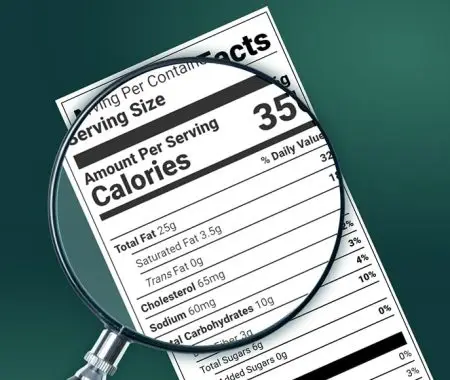Navigating the complexities of food labeling regulations in Mexico is crucial for any business involved in the food industry. According to Mexican Official STANDARD NOM-051-SCFI/SSA1-2010, a food additive is defined as any substance, whether natural or synthetic, that is intentionally added to food to affect its characteristics or properties. Under the current regulations in Mexico, food additives must be clearly and comprehensively declared on the food package or label within the ingredient list.
Compliant labeling on your food packaging is essential for meeting legal requirements and also builds consumer trust by providing clear and accurate information about food additives. Platforms like Food Label Maker can simplify this essential process, by offering tools and resources that streamline the creation of labels that meet Mexico’s stringent regulations.
TLDR
- Food Additives Overview: Substances used to improve flavor, appearance, texture, or shelf life of food. Regulations for food additives are governed by General Health Law and Regulation of Sanitary Control of Products and Services.
- Approval Process: Additives must be evaluated and approved by COFEPRIS before use in food products.
- Labeling Requirements:
- Clearly label additives with their specific name, intended function, and concentration.
- List additives in descending order by weight.
- Declare allergens or hypersensitivity-causing additives.
- Common Additives:
- Preservatives (e.g., sodium benzoate) with function noted.
- Colorants (e.g., tartrazine) with allergen declarations if applicable.
- Flavor enhancers (e.g., monosodium glutamate) with clear labeling.
- Labeling Steps:
- Identify and list all additives by name or E-number.
- Classify additives by function on the label.
- Follow formatting guidelines for legibility.
- Note health impacts and allergenic properties.
- Regularly review and ensure compliance with regulatory updates.
- The Role of Additives: Enhances food quality, safety, freshness, taste, texture, and appearance.
- Consumer Perception Towards Additives: Often negative, highlighting the need for transparent labeling and consumer education.
- Compliance Tools: Platforms like Food Label Maker simplify creating compliant labels and keeping up with regulations.
Understanding Mexican Regulations on Food Additives Labeling
Food additives are substances that can be used for various purposes, such as improving flavor, appearance, texture, or the shelf life of the food. The definition and regulation of food additives in Mexico are governed by the General Health Law and the Regulation of Sanitary Control of Products and Services. These governing bodies state that additives must be evaluated and approved by the Federal Commission for the Protection against Sanitary Risk (COFEPRIS) before they can be used in food products.
The current regulations require that food additives must be clearly labeled on food products. This labeling must include the specific name of the additive, followed by its intended function, and its concentration within the product. For example, if an additive is used as a preservative, it should be listed as “sodium benzoate (preservative)” in the ingredient list.
Additives, like all ingredients, must be listed in descending order of their proportion by weight in the product. If an additive causes any hypersensitivity or allergies, it should also be declared. The aim of this clear labeling is to ensure that consumers are fully informed about the contents of their food and if it could potentially impact their health.
See How FoodLabelMaker Can Help You
List of Common Food Additives and Labeling Requirements
In Mexico, food additives such as preservatives, colorants, and stabilizers are commonly used to enhance food quality and shelf life. The Mexico Federal Commission for the Protection against Sanitary Risk (COFEPRIS) has recently released an amendment to Annex VI regarding its food additive regulations. This amendment lists additives and adjuvants that can be used immediately once evaluated and approved by the Secretariat, as long as the latter Agreement is updated. For more detailed information on additives, you can read through the full document here.
Each additive used must be explicitly declared on the label, along with its purpose and E-number (which have been included in the examples below). For instance:
Preservatives:
- Sodium benzoate (E211): Must be listed by its specific name or E-number, with a note on its function, such as ‘preserves freshness’.
- Potassium sorbate (E202): Commonly used in processed foods to inhibit molds and yeasts. Must be clearly labeled as a preservative to inform consumers.
Colorants:
- Tartrazine (E102): An organic dye that should be labeled with its common name and a declaration if it is known to cause allergies or other adverse effects.
- Allura Red AC (E129): Normally used in candy or jellies, it must be indicated by its specific name or E-number, including any potential adverse health effects it may cause.
Sweeteners:
- Aspartame (E951): Needs to be clearly identified on labels, mentioning it is used as an artificial sweetener.
- Sucralose (E955): Should be listed with its function as a non-caloric sweetener, often used to replace sugar.
Flavor Enhancers:
- Monosodium glutamate (E621): Also known as MSG, this additive is used for more of a salty flavor or enhancing food flavor in general, and needs clear labeling.
Emulsifiers and Stabilizers:
- Lecithin (E322): Used to stabilize food textures; it should be labeled with its function and source (e.g., comes from soy or egg).
- Xanthan gum (E415): Should be clearly labeled as a stabilizer or thickener, indicating its role in improving food consistency.
These requirements ensure transparency and allow consumers to make informed dietary choices, particularly concerning allergens or additives with dietary restrictions.
How to Label Food Additives Properly
Proper labeling of food additives is not only a regulatory requirement in Mexico but also a component of consumer safety and trust. Here’s a step-by-step guide to ensuring your food product labels meet Mexican standards:
- Identify All Additives: Start by accurately identifying all the additives in your product. Each additive must be listed by its specific name or an internationally recognized E-number.
- Classify Additives: Clearly classify the function of each additive (e.g., colorant, preservative, flavor enhancer) on the label in the ingredient list, so consumers can understand their purpose.
- Follow Formatting Guidelines: Utilize the formatting guidelines set by Mexican food safety authorities, which include using legible font sizes and placing information in a visible location on the packaging.
- Include Health Information: If any additives have known health impacts, such as allergenic or hypersensitivity reactions, these must be clearly noted adjacent to the additive listing.
- Double-Check Compliance: Regularly review regulatory updates to ensure your labels remain compliant with any changes in food labeling laws.
Your labels need to be as accurate and as transparent as possible. This not only follows legal standards but offers crucial information so that consumers can make informed dietary choices and be protected from any health risks.
The Role of Food Additives in Food Processing
Food additives can enhance a food’s overall quality and safety, so they play an important role in food processing. These additives, whether they are natural or synthetic, are added into food products to maintain or improve their freshness, taste, texture, appearance, or nutritional value. For example, preservatives like sodium benzoate and antioxidants like ascorbic acid prolong the shelf life of foods by preventing it from going off. Flavor enhancers, like monosodium glutamates (MSGs), can make food taste better and more appetizing to consumers. Additionally, color additives like tartrazine give products a bright appearance. This might catch a consumer’s attention more easily and it can be helpful for marketers who need to advertise the product.
However, consumers have a preconceived idea of food additives, and it usually has more negative or warped perceptions by the public. While regulatory bodies like the FDA and EFSA make sure that approved additives are safe for consumption, there also needs to be education and transparent labeling. This is so that misinformation is dispelled and that more trust is built between the brand and a consumer. Additives require the use of innovative technology to integrate them into the food product so it helps this scientific aspect thrive in the food industry. Additives can ultimately benefit both producers and consumers without compromising on anyone’s health or the quality of the food product.
Utilizing Software for Compliance
Food Label Maker is a platform that simplifies the creation of compliant labels with the inclusion of food additives. Not only is their nutrition facts software efficient and easy to use, but they also have customizable templates that can be altered to your business needs. Whether your products are sold in the UK, the US, or Mexico, Food Label Maker’s software aligns your labels with the format and regulations of the country you choose to product in. They also perform regular updates to their software so that labels are always congruent with current standards and regulations.
They also have a number of nutritionists and experts who you can consult with any B2B company if you need more help on product or nutrition specifics. They offer guidance so that you can find a more clear direction through the current regulatory landscape. Food Label Maker and other platforms like it are a great way for you to be compliant and focus on other operational areas while all the work is done efficiently and effectively for you.
Conclusion
Food additives are added to a product during its processing stage to enhance its quality, extend its shelf life, or affect another aspect of its properties for safety reasons. COFEPRIS and other regulatory bodies in Mexico have stated that additives need to be clearly and concisely labeled on food products for consumer visibility and so that they can make more informed health choices. Businesses need to follow these standards so that they do not face any legal penalties or cause harm to any of their customers.
Food Label Maker also stands out as a platform that can significantly ease the complications of compliance and create intriguing food labels for your clients. Many consumers have mixed perceptions when it comes to food that contains additives, so resources like this guide and Food Label Maker’s Regulatory Hub act as a way to educate consumers and encourage them to see additives as more of a benefit. We encourage readers to explore Food Label Maker’s solutions, not just to help you with compliance efforts but as a way to contribute to a safer and more transparent food industry.



